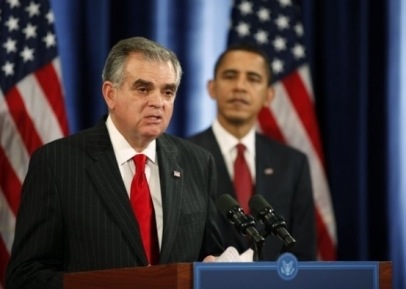Senate Eyes Public Transit as Climate Change Solution
Federal strategies for tackling climate change are doomed to fail without concerted efforts to keep Americans out of their cars -- efforts that will necessarily include a greater emphasis on public transit, Transportation Secretary Ray LaHood told Senate lawmakers Tuesday.
Jul 31, 202011.1K Shares2.7M Views
Transportation Secretary Ray LaHood, pictured with President Barack Obama (dot.gov)
Federal strategies for tackling climate change are doomed to fail without concerted efforts to keep Americans out of their cars — efforts that will necessarily include a greater emphasis on public transit, Transportation Secretary Ray LaHood told Senate lawmakers Tuesday.
The statement arrives just a few weeks after House lawmakers passed sweeping reforms aimed at reducing the nation’s greenhouse gas emissions, but included in the proposal only meager fundingfor public transportation projects.
Illustration by: Matt Mahurin
While the Obama administration this year adopted tough new emissions standardsthat will force automakers to make cleaner cars and trucks, LaHood warned that those efforts alone won’t address the climate change problem if Americans continue to drive as much as they do today. Indeed, even if vehicle fuel efficiencies doubled over the next two decades to 55 miles per gallon, he told members of the Senate Environment and Public Works Committee, the resulting decrease in greenhouse emissions would be merely “modest” without a simultaneous reduction in vehicle-miles traveled, or VMT.
“Addressing VMT growth plays a key role in decreasing transportation related greenhouse-gas emissions and should be included in overall efforts to prevent climate change,” LaHood said. “Failing to recognize the connection between transportation and climate change will likely jeopardize our ability to achieve our [emission] reduction goals.”
LaHood’s comments came as Senate Democrats are still in the process of drafting controversial climate change legislation designed to cut the nation’s emissions more than 80 percent by 2050. Like the House bill, the Senate proposal is expected to feature a cap-and-trade structurethat would effectively commodify pollutants, holding the nation’s largest emitters financially accountable for the greenhouse gases they spew. The revenue generated, the theory goes, could then be used to fund renewable-energy technologies and other green initiatives, including public transit projects. Some lawmakers have been pushing for 10 percent of cap-and-trade revenue to go toward public transportation, bike lanes and other “smart-street” initiatives.
After a great deal of political sparring and industry lobbying, however, a very different model emerged from the House. Indeed, under the House proposal, 15 percent of the value of the polluting permits distributed under the cap-and-trade system would go initially to benefit big polluters like the paper, steel and cement industries; 5 percent would target coal-burning power plants; 2 percent would help oil refineries; and another 2 percent would go to electric utilities. But just one percent — or roughly $537 million — would go to fund public transit projects, a real-dollar figure that would rise to roughly $1 billion by 2020.
And Senate passage of a climate bill this year is hardly a certainty. Even with all of the concessions to the polluting industries and their congressional defenders, the House proposal passed the lower chamber last monthby the slim count of 219 to 212, with 44 Democrats voting against it. Already, Democratic infighting over the Senate bill has forced party leaders to push the releaseof the proposal from July to September, when Congress returns from its month-long summer recess.
Environmentalists, state officials and many congressional lawmakers are hoping the delay will allow Senate leaders the time to carve out more room for public transit than House Democrats did. And they cite some strong reasons for their push.
The United States emits about 21 percent of the world’s greenhouse gases, of which nearly 30 percent come from transportation. And, if current trends hold, those numbers are expected to rise precipitously. Indeed, between 1977 and 2007, the number of vehicle-miles traveled by Americans jumped 110 percent even as the population rose just 37 percent, according to Steven Winkelman, director of transportation programs at the Center for Clean Air Policy. Looking ahead, per capita VMT is projected to rise 15 percent by 2030, the Energy Information Administration estimates.
“Although this is a slower growth rate than the recent past, it will effectively offset the emissions savings expected from the improved fuel efficiency and low carbon fuels requirements [of Congress and the Obama administration],” Winkelman told lawmakers Tuesday. Ignoring transportation in climate change legislation, he added, “will neglect opportunities to meet overall emission reduction goals while increasing the burden on other sectors of the economy.”
But it must be done carefully, proponents warned. David Bragdon, president of the Portland Metro Council, cautioned that building new transit infrastructure would be futile without land-use management plans to accompany it. Efforts to prevent sprawl, for example, and to concentrate populations around both public transportation and commercial facilities go a long way to keep people out of cars, he said.
“We can’t simply reform the supply of transportation, we have to reduce demand,” Bragdon testified, “and the way our communities are laid out is a major determinant of demand.”
Conservatives, meanwhile, used Tuesday’s hearing to blast the Democrats for their plans to take up a cap-and-trade bill at all. That strategy, they argue, would force businesses to hike costs on consumers at a time when the country continues to suffer from the financial downturn.
Sen. James Inhofe (Okla.), senior Republican on the Senate Environment panel, pointed to recent layoffs in the trucking industry as just one reason why Democrats should abandon their plans to put a price tag on greenhouse emissions. “If we enact cap-and-trade legislation, fuel prices will rise, and more jobs in the trucking sector will be destroyed,” Inhofe said.
For his part, Sen. George Voinovich (R-Ohio) was more concerned with the cost associated with new high-speed rail and other public transit projects, arguing that the deficit spending is already through the roof in the wake of the long series of financial bailouts.
“How are we gonna pay for it?” Voinovich asked LaHood. “Borrow more money?”
At least one funding option, it appears, is off the table. The 18.4 cent-per-gallon gas tax— though it hasn’t been raised since 1993, nor is it indexed for inflation — is not being eyed for a hike, LaHood assured lawmakers. “We are not for raising the gas tax,” he said.
That’s sure to be music to the ears of many conservatives, who argue that such a tax would cripple businesses and consumers reliant on energy-intensive goods and services. Yet, the idea of a gas-tax hike found an unlikely cheerleader this week, when the U.S. Chamber of Commerce came out in support of a “modest” increase as “the simplest, most straightforward way” to keep up with the nation’s crumbling infrastructure.
“The U.S. Chamber of Commerce has never been accused of being a strong proponent of any kind of tax increases,” Janet Kavinoky, the Chamber’s director of transportation infrastructure wrote for Roll Call Monday. “But taxes paid on gasoline and diesel are different — they are user fees.”
That’s different than saying the money should go to fund public transit. But when the nation’s largest business federation advocates a tax hike, it sure dulls the Republican claim that any such increase would strike a death knell for the country’s small businesses.

Camilo Wood
Reviewer
Camilo Wood has over two decades of experience as a writer and journalist, specializing in finance and economics. With a degree in Economics and a background in financial research and analysis, Camilo brings a wealth of knowledge and expertise to his writing.
Throughout his career, Camilo has contributed to numerous publications, covering a wide range of topics such as global economic trends, investment strategies, and market analysis. His articles are recognized for their insightful analysis and clear explanations, making complex financial concepts accessible to readers.
Camilo's experience includes working in roles related to financial reporting, analysis, and commentary, allowing him to provide readers with accurate and trustworthy information. His dedication to journalistic integrity and commitment to delivering high-quality content make him a trusted voice in the fields of finance and journalism.
Latest Articles
Popular Articles

